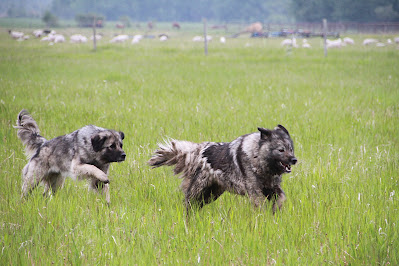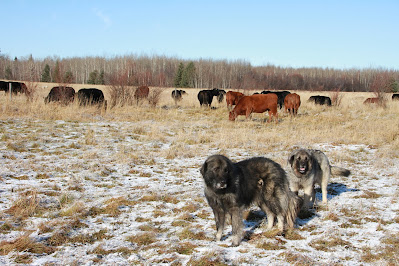Should I get two LGD at the same time?
©Louise Liebenberg(2021)
Written for The Shepherd's Magazine.
Very often people post that they have just bought their first two livestock
guardian dog (LGD) puppies! Most people are excited for this journey and are
looking for information on how to raise them correctly, within a few short
minutes the opinions start rolling in:
·
Fantastic, you must have two puppies together as
they will keep each other company,
· Oh no, get rid of one, as it is near impossible
to raise two pups at the same time,
·
Read about littermate syndrome
·
Littermate syndrome does not exist
·
LGD cannot work alone
·
It is better to raise one first, before adding
another
·
Only a bad breeder will sell you two pups at the
same time
·
Good for the breeder to sell you two, they work
best in two’s
The person posting this just gets overloaded with multiple
contradicting opinions. Now what to do? None of these opinions are completely
right, or wrong, they are usually based on each person’s own experience. That
experience however, could range from a LGD breed being kept in a pet home to a
working ranch with thousands of ewes grazing large ranges. So, this article is
going to take a closer look at some of these statements.
I believe that the success of having two puppies at the same
time is very dependant on things such as acreage, predator pressure number of
livestock, type of livestock, experience of the owner, how much time an owner
has for these pups and finally and if the breeder can mentor the buyer.
The biggest problem with raising two pups, (siblings or pups of a similar age) is that issues
only show after a few months. Nine-week-old pups are usually great
together, however at nine months old these pups can show a range of problematic
behaviour. Things such as hyper bonding to each other rather than to the stock,
getting into mischief together, double teaming the livestock causing injuries,
roaming and the high potential of fighting once they start reaching maturity.
These problems are often lumped together and called littermate syndrome. The biggest challenge for the owner is to be
able to recognize problem behaviour and intervene before behaviours become
established.
Pups that are not bonded to the livestock generally show no
attentiveness or even protectiveness toward the livestock, this in turn can
affect the trustworthiness of the pups as they have not developed a
relationship with the livestock to the point where the dogs feel they need to
protect them. The pups become more obsessed with each other and pay less
attention to the owner or the livestock. Separating these pups is usually the
solution, however it can become a nightmare as they will be very persistent in
escaping to be with one another. Some dogs end up fighting so badly, that they
can often never be together again. All, in all the challenges that arise from
raising multiple young dogs together can result in an owner being unable to
manage these dogs effectively. Most times, one dog ends up being rehomed, shot,
or becomes the porch dog. This is the
main reason why the general advise to new owners is not to acquire two pups at
the same time, particularly if the owners are new to owning LGD.
 |
| This single pup in Macedonia is allowed to go with the shepherd when he is out grazing the goats. |
On a small operation the problems can be exacerbated as the dogs have no
opportunity to get away from each other, this can lead to more tensions between
them. With small operations there is generally less stimulation (work, movement,
smells or other LGD) for younger dogs, which equates to boredom. Bored dogs get
into trouble! Two together, generally means double trouble!
It is true that two pups do keep each other company, they
can burn off excess energy and can play with each other. Some people find this
playing with each other redirects them from playing with the livestock. This
may be true for some but not all LGD pups. Most sheep cannot survive two large
adolescent pups running them down, nipping them or pulling wool. Dogs who play
excessively with each other, tend to take longer to mature as this constant
play, keeps them in a juvenile mindset for longer. It is hard for the owner to
get a handle on two naughty pups without separating them. Which then, defeats
the point of acquiring two at the same time.
 |
| Some playing between young dogs is normal, the problem is, if it becomes excessive to the point they are only focussed on each other, and not the livestock. |
There are situations where having siblings or pups close in age can work. In
range operations where there is a lot of work, large numbers of livestock and high
predator pressure the young dogs have enough work, space, and stimulation to
keep them busy and occupied. Other, older dogs will help loosen a hyper
attachment to each other, and a very clear pack hierarchy provides some
stability to these adolescents. Having two LGD pups in this situation is not
usually a big issue as these dogs can move away from each other and they are
not forced to interact constantly with each other. They can become more
independent of one another. On larger, or more traditional type of sheep
operation there is usually a shepherd who can supervise the dogs for the most
part during the day and it is the shepherd who will take control if it appears
these young dogs are getting into trouble. On bigger operations, pups can be
raised separately if needed, as there are often multiple flocks. I can separate
young dogs between the main ewe flock, or with the rams and sometimes with the
cattle. I have the space, facilities, and work to be able to raise two LGD
effectively.
In traditional shepherding countries, it is common to see multiple pups raised together,
more often than not, these pups, when a bit older (3-4 months) are kept chained
up or kennelled for the largest portion of the day. They can accompany the
shepherd provided they are not a nuisance. Any young pups that misbehave are
reprimanded quite harshly. These pups do
not have free range access to each other, or the livestock, only when the
shepherd is around.
 |
| Young pups are rarely left to just free-range; most shepherds do contain them either by kennelling or chaining. |
 |
| Dogs on a tether. They are tethered until the shepherd heads out for a day of grazing. |
 |
| A young female, from a shepherd in Macedonia. Most young dogs are chained up until it is time for them to work. |
Alot of people are correct when saying that LGD can not or should not work alone. Yes, having more than one does add an extra layer of protection for the livestock and the dogs. It allows the dogs to have some rest and if one is injured the flock is not left vulnerable. It takes time (years) to build a good team of dogs, ideally the ages, and experience of the dogs is staggered. It is good to have more than one dog working on sizeable operations, but on many smaller homesteads, one dog is often enough.
The hardest part with the having two LGD at the same time,
is the total lack of predictability in how things will evolve over time. It is like Russian Rolette, you may be lucky, but you may also not be. With two pups, it may work out really well or it may be lots of vet bills, injured dogs and long term separation due to the fighting.
A few people have success with it, and even
more, end up with a train wreck. The
most important considerations should be is their enough work, space, and livestock
to raise two pups together? Are there facilities in place to be able to
separate the dogs and does the owner have experience/time to manage two pups
who might not be showing stellar behaviour around the livestock?

